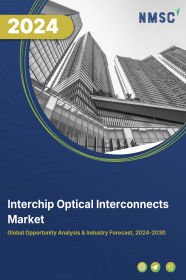
Interchip Optical Interconnects Market by Product (Optical Transceivers, Optical Fibers, Optical Engines, Silicon Photonics, and Others), by Interconnect Level (Chip and Board-Level, Board-to-Board and Rack-Level, and Metro and Long-Haul), by Distance (Less than 10 Km, 11 - 100 Km, and More than 100 Km), by Application (Data Communication, Telecommunication, Military and Aerospace, and Automotive) – Global Opportunity Analysis and Industry Forecast 2024-2030
US Tariff Impact on Interchip Optical Interconnects Market
Trump Tariffs Are Reshaping Global Business
Interchip Optical Interconnects Market Overview
The global Interchip Optical Interconnects Market size was valued at USD 14.05 billion in 2023 and is predicted to reach USD 31.11 billion by 2030 with a CAGR of 12.0% from 2024-2030.
The interchip optical interconnects market comprises the development and integration of optical technologies that enable data transfer between chips using light instead of traditional electrical signals. These optical interconnects are employed to meet the increasing demand for high-speed, low-power communication between integrated circuits, primarily in advanced electronics.
Their key advantage lies in the ability to reduce signal loss, energy consumption, and heat generation, making them essential for data centers, telecommunications, high-performance computing, and industries requiring rapid data processing. Optical interconnects facilitate efficient data flow in complex systems, enhancing overall performance in emerging technologies such as silicon photonics and photonic integrated circuits.
Market Dynamics and Trends
The global surge in data center construction and expansion drive the adoption of optical interconnects, facilitating high-speed and energy-efficient data transmission. Major companies such as Amazon, Microsoft, and Google consistently report their data infrastructure growth, highlighting a strong correlation between increased data center capacity and the necessity for enhanced data processing and throughput through optical interconnect solutions. For example, in January 2023, ManageEngine launched two new data centers in Toronto and Montreal to enhance data security and comply with local regulations.
Similarly, in May 2024, Microsoft opened its first hyper-scale cloud data center in Queretaro, Mexico, to support digital transformation by offering local access to cloud services such as Azure and Microsoft 365, thus improving security and reducing latency for businesses. These developments emphasize the vital role of data centers in meeting the growing demand for efficient data management solutions.
Moreover, the rise of artificial intelligence (AI) applications boost processing power requirements globally, increasing the demand for faster interconnects between chips. This trend necessitates advanced optical interconnect solutions to manage large datasets and improve system performance. The global emphasis on AI across various sectors underscores the need for upgraded interconnect technologies to support expanding workloads.
According to a survey conducted in the fourth quarter of 2023, 29% of the 644 respondents from organizations in the U.S., Germany, and the U.K. indicated that they deployed and are actively using generative AI. As businesses continue to expand their AI initiatives, investments in technologies become vital for maintaining competitiveness in a rapidly evolving interchip optical interconnects market demand.
Furthermore, the expansion of the semiconductor industry drives the optical interconnects demand, as advancements in semiconductor technology require faster and more efficient data transmission solutions. This growing need for enhanced interconnects aligns with the industry's trend toward increasingly complex chip designs.
The Semiconductor Industry Association (SIA) reported that global semiconductor sales reached USD 53.1 billion in August 2024, reflecting a 20.6% increase from USD 44.0 billion in August 2023. This growth highlights the critical need for innovative interconnect technologies to keep pace with evolving semiconductor capabilities. However, high initial investment costs associated with implementing optical interconnect technologies restraints the interchip optical interconnects market growth.
On the contrary, the expansion of 5G networks and advancements in telecommunications infrastructure creates ample opportunities of the market in the upcoming years. As these technologies continue to develop, the demand for high-speed interconnects will rise, with optical solutions offering enhanced bandwidth and improved reliability for communications.
Market Segmentations and Scope of the Study
The interchip optical interconnects market report is segmented on the basis of product, interconnect level, distance, application, and region. On the basis of product, the market is divided into optical transceivers, optical fibers, optical engines, silicon photonics, and others. Based on interconnect level, the market is segmented into chip and board-level, board-to-board and rack-level, and metro, and long-haul. Based on distance, the market is divided into less than 10 km, 11 - 100 km, and more than 100 km. On the basis of application, the market is sub-divided into, data communication, telecommunication, military and aerospace, and automotive. Regional breakdown and analysis of each of the aforesaid segments includes regions comprising of North America, Europe, Asia-Pacific, and Rest of The World (Row).
Geographical Analysis
The North America region dominates the interchip optical interconnects market share during the forecast period due to the rapid growth of the semiconductor industry. This expansion encourages a heightened demand for advanced interconnect technologies, essential for supporting increased data processing capabilities and more complex chip architectures.
According to recent reports published by the Semiconductor Industry Association, U.S. semiconductor companies generated sales of USD 275 billion, representing 48% of the global market in 2024. This significant market presence positions the region as a key player, and is driving further innovation and investment in interchip optical interconnect solutions to meet the evolving demands of the semiconductor sector.
Moreover, the rise in AI and machine learning applications across the region increases the demand for faster data processing, that directly drives the need for advanced optical interconnects to efficiently handle growing data volumes.
According to the AI Industry Ecosystem Association CIC, the U.S. maintains the most powerful AI sector, with approximately 8,950 companies operating in the field and nearly 6,025 active investors, underscoring its leadership in AI development and funding. The growth in AI and machine learning applications sets the region's demand for advanced optical interconnects to meet the expanding need for faster, efficient data handling.
On the other hand, Asia-Pacific is expected to witness a steady rise in the interchip optical interconnects industry during the forecast period. The rapid expansion of the telecommunications industry drives the demand for interchip optical interconnects in the region, as the rollout of 5G networks, creates a need for faster data transmission and advanced optical interconnect solutions. As per Ministry of Commerce and Industry, India ranks as the world's second-largest telecommunications market, with projections indicating that the number of 5G subscriptions will reach 350 million by 2026, making up 27% of all mobile subscriptions. This trend highlights the increasing necessity for advanced interconnect technologies to support the burgeoning telecommunications infrastructure in Asia-Pacific.
Moreover, the rapid evolution of the automotive sector in the region further drives the demand for interchip optical interconnects, as increasing integration of advanced technologies necessitates faster data processing capabilities. The growing reliance on autonomous driving systems, advanced driver-assistance systems (ADAS), and enhanced in-vehicle connectivity fuels the need for efficient optical interconnect solutions.
For instance, in June 2024, nine Chinese automakers, including well-known brands such as BYD and Nio, received approval from the Ministry of Industry and Information Technology to conduct tests of Level 3 self-driving vehicles in designated areas across seven cities. As the automotive sector evolves, the optical interconnects market stands to experience significant growth, driven by the demand for innovative solutions that support this technological transformation.
Competitive Landscape
Various key market players operating in the Interchip Optical Interconnects industry includes 3M Company, Sumitomo Electric Industries, Ltd., Intel Corporation, Amphenol Corporation, TE Connectivity, Ciena, Infinera, Huawei Technologies Co., Ltd., Corning Inc., and others. These market players are adopting various strategies such as product launches to remain dominant in the market.
For instance, in June 2024, Intel launched its fully integrated optical compute interconnect (OCI) chiplet, designed to enhance high-speed data transmission for AI infrastructure. This innovation enables co-packaged optical I/O with Intel CPUs, significantly boosting bandwidth, reducing power consumption, and supporting longer transmission distances.
Furthermore, in January 2024, Sumitomo Electric launched a new section on its website dedicated to fiber optic products, emphasizing their importance in the infrastructure supporting 5G networks and data centers. Such initiatives indicate a shift toward more integrated optical interconnects, essential for meeting the increasing data requirements of modern applications.
Key Benefits
-
The report provides quantitative analysis and estimations of the interchip optical interconnects market from 2024 to 2030, which assists in identifying the prevailing industry opportunities.
-
The study comprises a deep-dive analysis of the current and future interchip optical interconnects market trends to depict prevalent investment pockets in the market.
-
Information related to key drivers, restraints, and opportunities and their impact on the interchip optical interconnects market is provided in the report.
-
Competitive analysis of the key players, along with their market share is provided in the report.
-
SWOT analysis and Porters Five Forces model is elaborated onthe study.
-
Value chain analysis in the market study provides a clear picture of roles of stakeholders.
Interchip Optical Interconnects Market Key Segments
By Product
-
Optical Transceivers
-
Optical Fibers
-
Optical Engines
-
Silicon Photonics
-
Others
By Interconnect Level
-
Chip and Board-Level
-
Board-to-Board and Rack-Level
-
Metro and Long-Haul
-
By Distance
-
Less than 10 Km
-
11 - 100 Km
-
More than 100 Km
By Application
-
Data Communication
-
Telecommunication
-
Military and Aerospace
-
Automotive
By Region
-
North America
-
The U.S.
-
Canada
-
Mexico
-
-
Europe
-
The U.K.
-
Germany
-
France
-
Italy
-
Spain
-
Denmark
-
Netherlands
-
Finland
-
Sweden
-
Norway
-
Russia
-
Rest of Europe
-
-
Asia-Pacific
-
China
-
Japan
-
India
-
South Korea
-
Australia
-
Indonesia
-
Singapore
-
Taiwan
-
Thailand
-
Rest of Asia-Pacific
-
-
Rest of the World (RoW)
-
Latin America
-
Middle East
-
Africa
-
Key Players
-
3M Company
-
Sumitomo Electric Industries, Ltd.
-
Intel Corporation
-
Amphenol Corporation
-
TE Connectivity
-
Ciena
-
Infinera
-
Huawei Technologies Co., Ltd.
-
Corning Inc.
-
Molex Electronics Solutions
REPORT SCOPE AND SEGMENTATION:
|
Parameters |
Details |
|
Market Size in 2023 |
USD 14.05 Billion |
|
Revenue Forecast in 2030 |
USD 31.11 Billion |
|
Growth Rate |
CAGR of 12.0% 2024 to 2030 |
|
Analysis Period |
2023–2030 |
|
Base Year Considered |
2023 |
|
Forecast Period |
2024–2030 |
|
Market Size Estimation |
Billion (USD) |
|
Growth Factors |
|
|
Countries Covered |
28 |
|
Companies Profiled |
10 |
|
Market Share |
Available for 10 companies |
|
Customization Scope |
Free customization (equivalent to up to 80 working hours of analysts) after purchase. Addition or alteration to country, regional, and segment scope. |
|
Pricing and Purchase Options |
Avail customized purchase options to meet your exact research needs. |

















 Speak to Our Analyst
Speak to Our Analyst




















